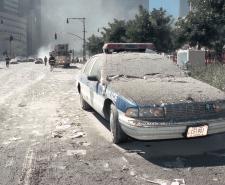
Read more about Mysteries

Three and a half decades on from the Lockerbie bombing, we look back at the incomprehensible horror and lasting impact of this devastating crime.
It was just after 7pm on 21st December 1988, and residents of the small Scottish town of Lockerbie were settling into the evening. Some were wrapping Christmas presents, others were watching This Is Your Life, which that night featured presenter Michael Aspel dressed up as Sooty.
The peaceful normality of the night was disturbed by what sounded like thunder, except that it just got louder and louder. Local woman Marjory McQueen got up to investigate what was happening and was met by a vision of horror: ‘Suddenly the whole sky turned orange, and there were flames hundreds of feet up into the air.’
Jasmine Bell, who was in the process of delivering Christmas food parcels, found herself caught in a literal firestorm, with ‘fire falling down from the sky’ and setting the ground around her alight. ‘Everything was burning,’ Bell later testified in court. ‘The driveway, the lawn, the hedges, the rooftops.’
In nearby Tundergarth, resident Kevin Anderson witnessed something slam with immense force into a field just outside his house. Venturing out with a torch, he discovered the entire nose of a massive plane which had been sheared away from the fuselage. This wreckage became the enduring, iconic image of the Lockerbie bombing.
The object that had fallen on Lockerbie that night was a Boeing 747. Specifically, Pan Am Flight 103, travelling to New York with 259 people on board. A bomb in the cargo hold had punched a hole in its side, with the resulting decompression of the fuselage causing the jumbo jet to disintegrate within seconds.
The flaming debris destroyed houses down below, killing 11 people on the ground. Residents found themselves suddenly surrounded by suitcases, handbags, books, and bottles scattered from drinks carts. Of course, there were also the bodies of the passengers, strewn on lawns, draped over hedges, and dotted around a golf course.
This grim intimacy with the deaths of strangers forged a kinship between the people of Lockerbie and the relatives of passengers. A group of residents made it their business to sort, wash and iron the clothes pulled from the wreckage, to deliver them to the families of the deceased.
One of these residents was Josephine Donaldson, who found a handbag stuffed with 21st birthday cards lying in her garden. They belonged to a passenger named Nicole Boulanger. Later, Josephine saw Nicole’s distraught mother on television, filmed as she waited in vain at the airport in New York.
By coincidence, Josephine was responsible for sorting and delivering the possessions of another passenger, Amy Shapiro, who’d also celebrated her 21st birthday on the same day as Nicole. She came to think of Nicole and Amy as ‘my two girls’, vowing that their relatives would receive whatever could be recovered.
The lingering trauma of Lockerbie is perhaps exemplified in the stories of local brothers Steven and David Flannigan. On the night of the disaster, 19-year-old David had been staying with a friend in Blackpool, while 14-year-old Steven had nipped over to a neighbour’s house. That left their parents and 10-year-old sister in the family home, which was obliterated by the inferno from above.
Having most of their family abruptly taken away had lasting repercussions for the brothers. David died just five years later in a Thailand hostel, having reportedly fallen down a spiral of drink and drugs. Steven, who was dubbed the ‘orphan of Lockerbie’ was raised in a succession of foster homes and also died tragically young, aged 26, when he was run over by a train after a night of heavy drinking.
Another man who continues to deal with the demons of Lockerbie is Jim Swire, whose daughter, Flora, was a passenger on Flight 103. Jim is the most well-known of the relatives, because of his activism with regards to the Lockerbie investigation and air travel in general.
In 1990, he made headlines after taking a fake bomb on a London to New York flight. He modelled it on the real Lockerbie bomb, stuffing a radio cassette player with marzipan instead of plastic explosives, to demonstrate how lax security still was at airports. Jim has also been a vocal defender of Abdelbaset al-Megrahi, the Libyan man convicted for his part in the bombing.
The question of who was behind Lockerbie is still fiercely debated. Jim Swire isn’t the only one who believes Abdelbaset al-Megrahi was innocent – many reporters and figures of authority have questioned the chain of evidence leading to Megrahi, particularly the inconsistent testimony of a key witness.
There’s also the question of motive. Did Libya’s Colonel Gaddafi order the bombing as retaliation for US attacks on Libyan warplanes and boats in the 1980s, and US air strikes carried out on Libya itself in 1986?
That could certainly be considered as strong motivation, but doubters of the Megrahi/Libya theory point to other suspects, such as Iran, which had been reeling from the accidental shooting down of an Iran Air jet by a US warship only months before Lockerbie.
Whether or not the truth will ever be conclusively known, the memories and repercussions of that December night continue to be felt, all these years later.